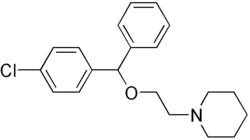Chemistry:Cloperastine
 | |
| Clinical data | |
|---|---|
| Other names | HT-11 |
| AHFS/Drugs.com | International Drug Names |
| Routes of administration | Oral |
| ATC code | |
| Identifiers | |
| |
| CAS Number | |
| PubChem CID | |
| DrugBank | |
| ChemSpider | |
| UNII | |
| KEGG | |
| ChEMBL | |
| Chemical and physical data | |
| Formula | C20H24ClNO |
| Molar mass | 329.87 g·mol−1 |
| 3D model (JSmol) | |
| |
| |
| | |
Cloperastine (INN) or cloperastin, in the forms of cloperastine hydrochloride (JAN) (brand names Hustazol, Nitossil, Seki) and cloperastine fendizoate, is an antitussive and antihistamine that is marketed as a cough suppressant in Japan , Hong Kong, and in some European countries.[1][2][3] It was first introduced in 1972 in Japan, and then in Italy in 1981.[4]
Side effects
Adverse effects may include sedation, drowsiness, heartburn, and thickening of bronchial secretions.[5]
Pharmacology
The precise mechanism of action of cloperastine is not fully clear, but several different biological activities have been identified for the drug, of which include: ligand of the σ1 receptor (Ki = 20 nM) (likely an agonist),[6] GIRK channel blocker (described as "potent"),[7][8][9][10] antihistamine (Ki = 3.8 nM for the H1 receptor),[3][6] and anticholinergic.[3][11] It is thought that the latter two properties contribute to side effects, such as sedation and somnolence, while the former two may be involved in or responsible for the antitussive efficacy of cloperastine.[6][7]
Synthesis
The halogenation of 4-Chlorobenzhydrol [119-56-2] (1) with phosphorus tribromide in tetrachloromethane gives 1-(Bromophenylmethyl)-4-chlorobenzene [948-54-9] (2). Treatment with ethylenechlorohydrin (2-Chloroethanol) [107-07-3] (3) gives 1-(4-Chlorobenzhydryl)oxy-2-chloroethane [5321-46-0] (4). Reaction with piperidine (5) completes the synthesis of Cloperastine (6).
See also
- Cough syrup
- Noscapine
- Codeine; Pholcodine
- Dextromethorphan; Dimemorfan
- Racemorphan; Dextrorphan; Levorphanol
- Butamirate
- Pentoxyverine
- Tipepidine
- Levocloperastine
References
- ↑ The Dictionary of Drugs: Chemical Data: Chemical Data, Structures and Bibliographies. Springer. 14 November 2014. pp. 301–. ISBN 978-1-4757-2085-3. https://books.google.com/books?id=0vXTBwAAQBAJ&pg=PA301.
- ↑ Swiss Pharmaceutial Society, ed (January 2000). Index Nominum 2000: International Drug Directory. Taylor & Francis. pp. 261–. ISBN 978-3-88763-075-1. https://books.google.com/books?id=5GpcTQD_L2oC&pg=PA261.
- ↑ 3.0 3.1 3.2 "Pharmacological and clinical overview of cloperastine in treatment of cough". Therapeutics and Clinical Risk Management 7: 83–92. 2011. doi:10.2147/TCRM.S16643. PMID 21445282.
- ↑ William Andrew Publishing (22 October 2013). Pharmaceutical Manufacturing Encyclopedia. Elsevier. pp. 1103–. ISBN 978-0-8155-1856-3. https://books.google.com/books?id=_J2ti4EkYpkC&pg=PA1103.
- ↑ Drugs Available Abroad, 1st Edition. Derwent Publications Ltd.. 1991. p. 29. ISBN 0-8103-7177-4.
- ↑ 6.0 6.1 6.2 "Identifying mechanism-of-action targets for drugs and probes". Proceedings of the National Academy of Sciences of the United States of America 109 (28): 11178–83. July 2012. doi:10.1073/pnas.1204524109. PMID 22711801. Bibcode: 2012PNAS..10911178G.
- ↑ 7.0 7.1 Pharmacology and Therapeutics of Cough. Springer Science & Business Media. 30 September 2008. pp. 230–. ISBN 9783540798422. https://books.google.com/books?id=Z4kXCSRq0OAC&pg=PA230.
- ↑ "Centrally acting non-narcotic antitussives prevent hyperactivity in mice: Involvement of GIRK channels". Pharmacology, Biochemistry, and Behavior 144: 26–32. May 2016. doi:10.1016/j.pbb.2016.02.006. ISBN 978-3-540-79842-2. OCLC 612742272. PMID 26892760.
- ↑ "[Is the GIRK channel a possible target in the development of a novel therapeutic drug of urinary disturbance?]". Yakugaku Zasshi 131 (4): 523–32. April 2011. doi:10.1248/yakushi.131.523. PMID 21467791.
- ↑ "[Novel antidepressant-like action of drugs possessing GIRK channel blocking action in rats]". Yakugaku Zasshi 130 (5): 699–705. May 2010. doi:10.1248/yakushi.130.699. PMID 20460867.
- ↑ Essentials of Medicinal Chemistry. Wiley. 16 August 1988. ISBN 978-0-471-88356-2. https://books.google.com/books?id=6hxtAAAAMAAJ.
- ↑ "[Effect of antihistaminic substances. I. Chemical constitution and pharmacological effect of the basic benzhydrylethers]". Arzneimittel-Forschung 4 (3): 189–194. March 1954. PMID 13159698.
- ↑ Anon., GB patent 1179945 (1970 to Yoshitomi Pharmaceutical).
- ↑ Anon., GB patent 670622 (1952 to Parke Davis & Co).
- ↑ Laura Puricelli, EP patent 0894794 (1999 to AESCULAPIUS FARMACEUTICI S.r.l.).
- ↑ 陶文潘, 潘文驰, 潘兴长, 罗泳萍, 樊希祥, CN patent 104327014A (2015 to 重庆市恒安化工有限公司).
 |


